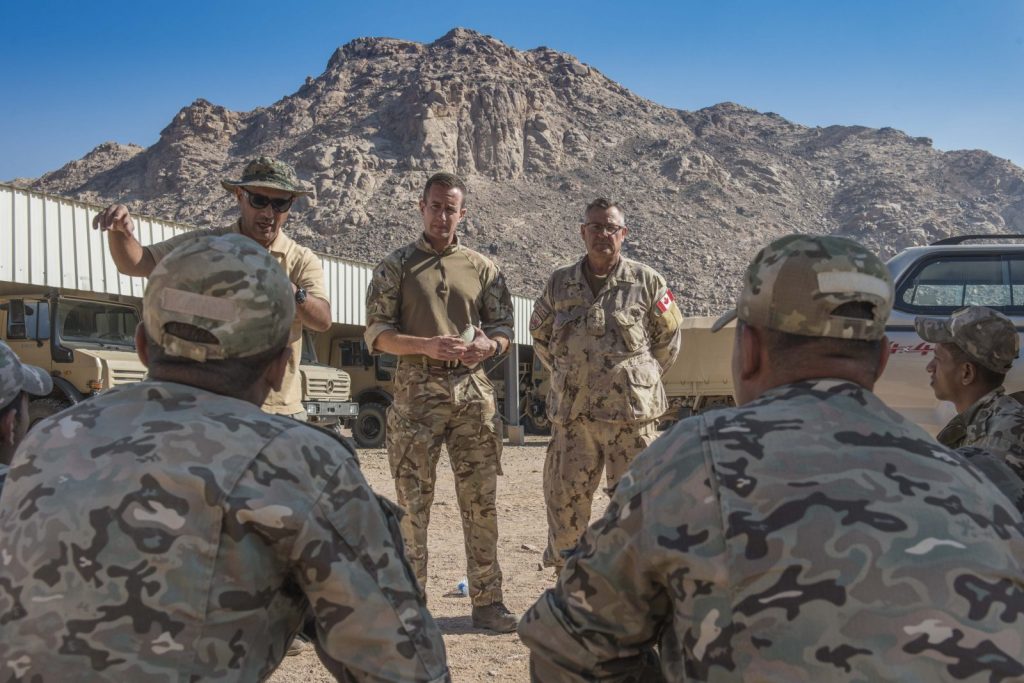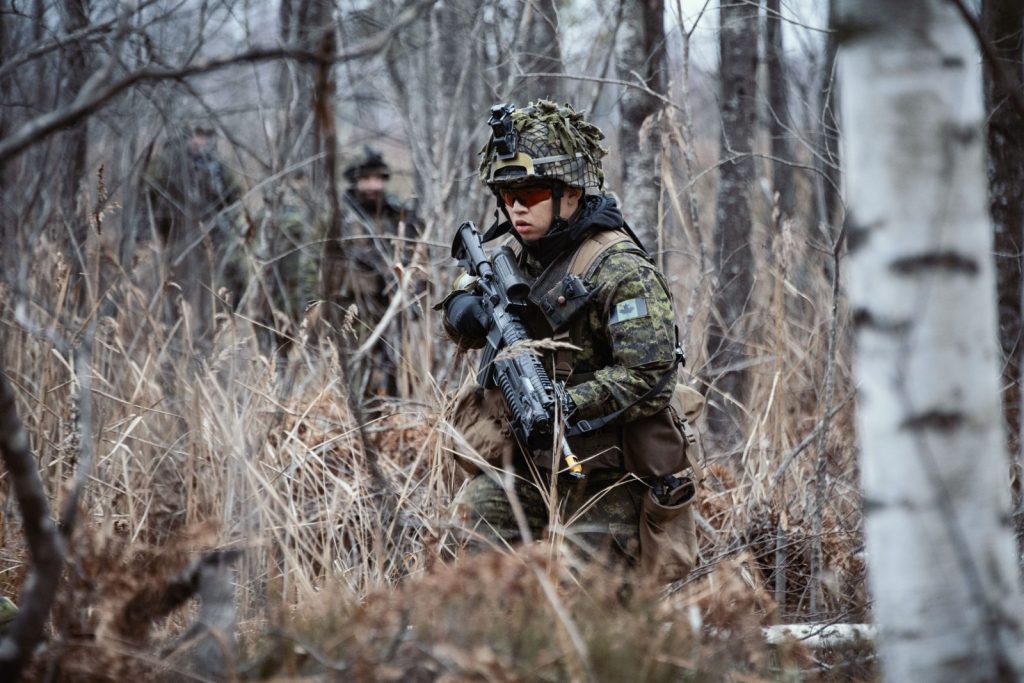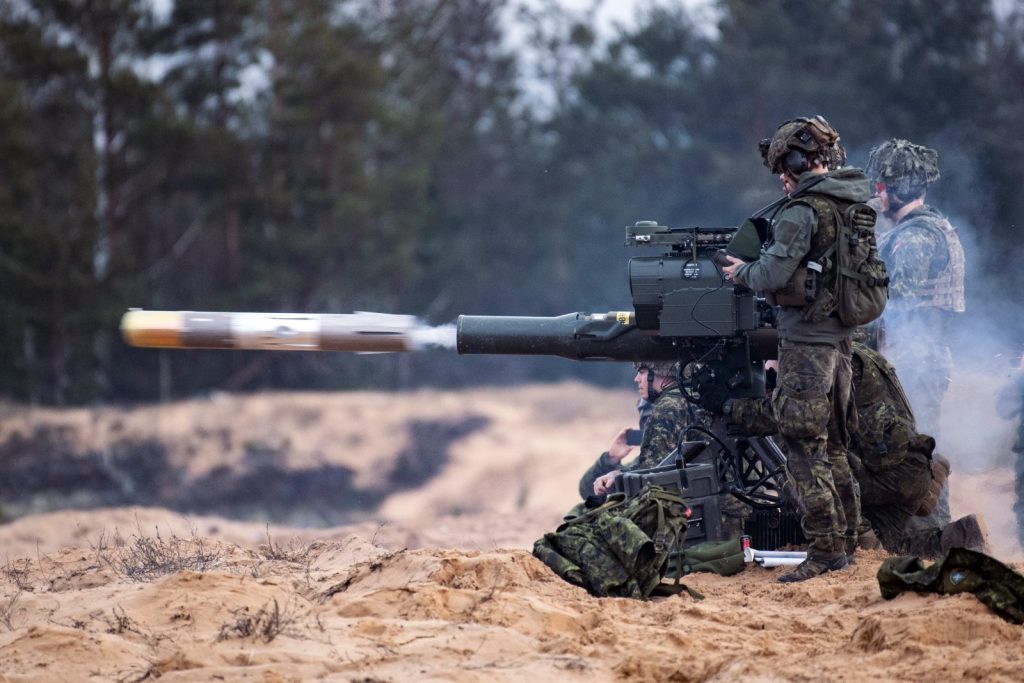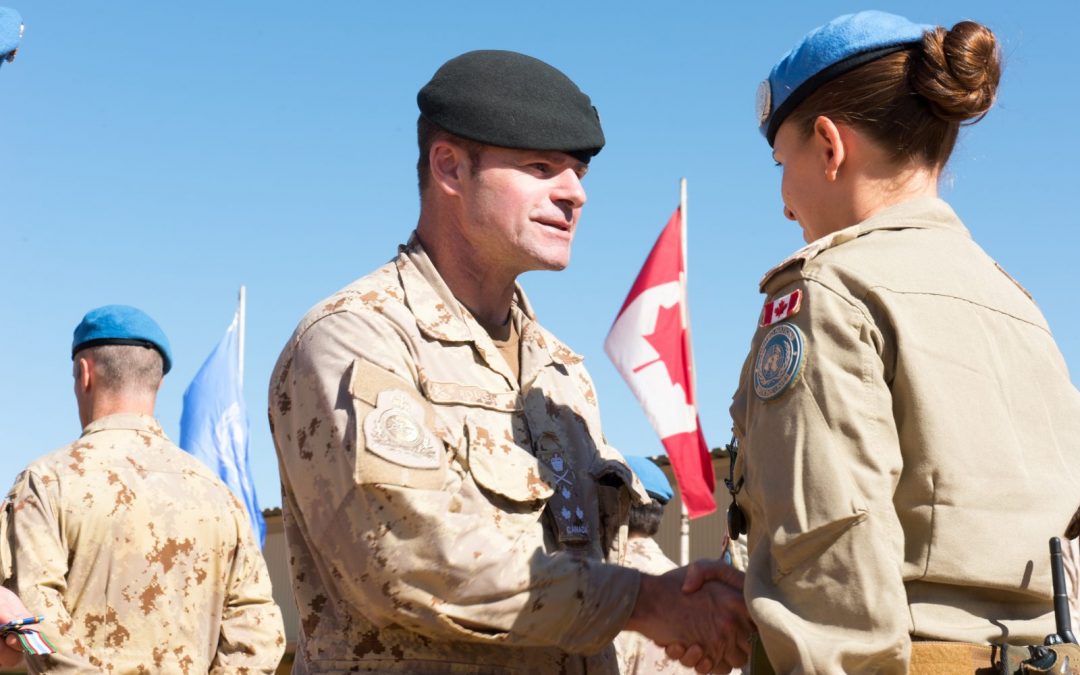The Canadian Armed Forces is at war everyday in the information domain. Whether in Latvia, Ukraine, Iraq, Africa or even at home, deployed forces face a barrage of false information that can quickly undermine or fail an operation. In recent presentations, including to the Canadian Intelligence Conference (CANIC 19) in December, Lieutenant-General Michael Rouleau, Commander of Canadian Joint Operations Command (CJOC), has argued for greater investment in information operations (IO) and intelligence (INT) functions. He spoke with editor Chris Thatcher.
You have described the information domain as the central theatre of operations. What are the implications for a force employer like CJOC?
I do think the information theatre is going to be, and is, the central theatre of conflict or warfare moving forward. That is, you could win a tactical battle, but if you don’t have the information space tightly sewn up, you’re effectively losing in the perception space and, therefore, losing.
The traditional view of information through the lens of public affairs is not sufficient. Public affairs folks have a massive role to play in the space, but I see IO more as a function of manoeuvre than technical public affairs expertise. We have to manoeuvre in the information space.
Since January, I’ve had an information component commander designated. He’s a combat arms colonel who leads my joint operations effects cell in CJOC, which itself is a relatively new creation. My public affairs team is connected into that information component commander. (He joins the traditional air and maritime component commanders – we don’t have a land component commander, but there’s a study ongoing right now to deliver in June as to what the LCC should look like – and the space, cyber and support component commanders.) It’s ad hoc, but I’m finding the fix within my own outfit.
This officer is able to take the public affairs perspective, the strategic communications perspective, some target audience analysis and put it in the context of the overall operation, not as a technical adjunct to what we’re doing, but as an integrated component of the planning and execution of the operation. What’s it going to look like in the future? It will become much more fleshed out and baked into our culture.
Does that allow you to be more proactive rather than reactive?
I’m coming up with expertise and the structural fits and aligning it with how we do business. So it’s part of the fit. The real part, I would argue, is in the policies, permissions and authorities space. How nimble can we be in terms of getting the message out? I’m not sure proactive is a word that I’d use a lot, because it’s much more nuanced than that; it’s deliberate. Some information will be reactive, but in a very quick manner. But some will be very deliberate and pre-planned. How that connects into our processes, our boards, our committees here in the headquarters where we do operations, all has to be worked out. We haven’t really delved into that substantively at this point.
What’s the effect of that on operations?
I told Lieutenant-Colonel Mike Reekie, our last commander of the battle group in Latvia, and the battle group, you guys aren’t doing land operations, you’re doing an information operation in the land domain. And that is part of our pan-domain force employment concept. I command the general-purpose force operations, but there’s so much more that happens in all of these regions bilaterally between the services and allied armies. And everything we do or don’t do sends a message. That’s the reality.
Christmas 1941, Soviet aircraft were dropping leaflets on German soldiers, propaganda basically saying, this is your living space, your Lebensraum, Merry Christmas. Today, we’re not dropping leaflets out of aircraft. It’s all happening in other, more subtle ways. And in some cases, states have co-opted the right to use that to drive wedges in the alliance. I think it’s very apropos that we get our head around this issue and make some good progress, because it’s a central tenet of future conflict.
That certainly mirrors a conversation we had with LCol Reekie last fall around a shifting narrative in Russian propaganda in Latvia. The distinction between conducting information operations in a land domain versus simply operating in the land domain, how significant is that given information operations have always been a part of conflict?
Materially on the ground, is it radically different? The answer’s probably no. But it’s very important that we signal this down to the lowest levels, because it underpins not just what we’re doing, but how we should be doing it. It’s an important cultural message as much as anything else. What happens at the tactical level today has much more resonance nationally and strategically than it did 20 or 30 years ago. There is a much faster and more immediate effect. To that end, I don’t think we can leave anything on the table with respect to imparting to our people the precise reason why they’re doing something. This is part of transparency with our younger soldiers, too. No surprises. Let’s tell you exactly what we think you’re doing on mission X or Y.

Warrant Officer James Wyszynski participates in a briefing with partner nations Jordan, UK, and the US before conducting Exercise Olive Grove, a joint training exercise in the Jordan desert as part of Operation IMPACT in Sept. 2019. Photo: Cpl Ryan Moulton
You’ve talked about information operations at the tactical level “squeezing” the operational and strategic levels: What has that done to the decision-making cycle?
There’s no question the operational level is being compressed. With departing task force commanders, I make sure that they understand where they fit. We get our authorities from Parliament and we owe accountability back to Parliament, the Minister, the Chief of the Defence Staff. All of a sudden, these relatively junior officers in the overall rank scheme find themselves next in the order with all that responsibility on them. There’s a greater pull for information, which means my headquarters has less time to assimilate, package, and transmit. We had to make some changes here to ensure that we were as flat and fit for purpose to the environment as possible. We are endeavoring to push more power to lower levels so that we can be faster.
One way of achieving that is by empowering people, by flattening the organization, by not treating information as a commodity to be hoarded, but as something that ought to be shared. We’re trying to do our part to adapt to the environment, telling the young people when they go forward what their role entails, but also leaning on the professional military education to say we have to up-armour people with better skills because the demands we’re imposing on them are more than the lieutenant-colonel felt in 1992.
To that end, you are in the process of developing a force employment concept (FEC) for IO.
The IO FEC is really the force employers’ expression of what we need the information space to do to enable us. It’s important that we understand that strategic communications or information operations are not ends in themselves; they’re part of the bigger picture, which is to win in this campaign or to win in this exercise. We are working with others to develop the IO FEC. It is one bespoke piece. One level up is the Pan-Domain Force Employment concept, the PFEC, and that is a by-product of the “How We Fight” work that has been done in the CAF over the last year. It is an overarching refreshed concept for how the CAF sees itself winning in the future. All of this is an effort to try to better align the force we have today and to enable us to visualize the force that we have to build in the future. The Force Mix Structure Design (FMSD) is a significant body of work that’s going to allow us to see where we have gaps in the people and the structure sides of the forces.
What then do you need from an information operator in this domain?
What I want is a commander who can speak authoritatively at my level, working for me and with my other components, to create the conditions in the information environment that support the objectives I’m supposed to achieve as given by the Chief. It’s more than public affairs. It’s more than media response lines. It’s not propaganda. I don’t want to get into emotional conversations that put a nefarious bent behind this. The reality is, we have troops around the world right now and we’re not looking at the information space as completely as we should.
There was a parade in Ukraine about a year ago, and the Russians took pictures of two of my troops on a stage with an orthodox minister and then spun that to say that we were somehow backing right wing ideology that dated from the Second World War. We have another picture that was taken from 10 feet beside that angle that shows the complete context, that there was a Jewish rabbi on the stage, a Catholic priest – it was a multi-faith event. If we are subject to that level of disinformation, I would like to be in a position to respond quicker so that we’re stemming the flow of nefarious ideas. That’s what it looks like for me. And this officer who’s commanding the component for me is nested into all the other domains, so we’re at that point stitching the information piece up with the work that’s happening in the space domain, in the maritime domain. It’s a much richer, more complete information perspective.

CAF members deployed with enhanced Forward Presence Battle Group Latvia participate in Exercise Winter Reaper at Camp Ādaži, Latvia, in November 2019.
Photo: Cpl Djalma Vuong-De Ramos
Is there a nexus between IO and intelligence in these operations?
Intelligence is the seminal foundation that, for me as a commander at the operational level, guides the kind of actions that I can take. We traditionally focus on the adversary. Where intelligence intersects a little bit with the information spaces is in white situational awareness. So, understanding the population, the environment, what social media is saying. We need to have the right policies, the right authorities to be able to look at the complete picture; not just the adversary who is in a particular country, but also the whole country. We’re there among the people, among a culture or a set of cultures. It just follows that we should have as complete an understanding of that and that our actions should be informed by that.
You have called for greater dexterity in intelligence and being able to operate at the speed of warfare. What’s your concern?
My concern is that as an enterprise, we’re not necessarily able to operate as quickly as we should or with the levels of precision that we should. Warfare is accelerating, so we need to be in a climate that acknowledges we have to be both fast and precise. Sometimes I feel like the inertia of the organization can result in a business-as-usual mentality, and we’re trying to say, no, the character of warfare is changing.
Are there capability gaps you want addressed?
As a force employer, I do think there are things we’re missing. I think we’re missing the ability to see the battlespace has completely as we should. There are deficiencies, therefore, in the ISR space. I think we have definite deficiencies in our ability to move data and information through the intelligence enterprise. That is a problem. I think, therefore, we have difficulty sifting through reams of information, separating the signal from the noise, finding the nugget that really matters to a particular commander and then building around that.
I’m not afraid to say, yes, I do think that extends to the cognitive space. Is the training that we’re doing moving towards a fit-for-purpose, state-on-state and non-state intelligence operator? I’m not sure it is, but I’m making sure that my colleagues are aware of how we see the character of warfare changing, and that they’re taking that and maybe adapting, if they need to, on their own.

CAF members fire a tube-launched, optically-tracked, wire-guided missile at the Camp Ādaži training area in Latvia in December 2019. Photo: Cpl Djalma Vuong-De Ramos
Many of the Army’s modernization projects around Land C4ISR are focused on hardware and software. What you are describing is a modernization of skill sets.
I’m a big believer that in the cognitive realm, we can get four or five times our return on the investment if we’re spending more time thinking about “peopleware,” not just hardware and software. A magic box of technology is not going to solve our problems. At the end of the day, it’s always going to come down to a particularly astute young man or woman who’s putting their mind, their creativity, their experience behind a problem. But we have to be enabled by technology.
In part, that is about training for operators. But it’s also about having commanders who know what questions to ask of IO and intelligence in order to get the most out of them.
That’s a great point. Oftentimes, you’ll hear a critique of the intelligence function, but the intelligence cycle starts with direction. We sometimes critique the very things that we don’t do a good enough job directing. I do think commanders need to take ownership of pointing the intelligence apparatus at the things that they need intelligence to look at. I’ve talked to the commandant of the Staff College about this, about professional military education and are we doing the right things. CJOC sent to the (Army, Navy, Air Force and other Line 1 commanders) about eight months ago a year’s worth of reflections of how our officers, our leaders are doing on operations. It was exactly around the point of trying to get the other L1s aware of where we see the really good and where we see the need for some improvement so that they, at their end, can make the decisions they need to make.
Where did IO fall within that spectrum?
Interesting, it didn’t really get well reflected because we’re really not doing much of it, especially at a tactical level. We’re doing public affairs at the tactical level. So the answer is, not much. Where it did get illuminated a bit was in Mali because of some of the staff officers in the United Nations Multidimensional Integrated Stabilization Mission (MINUSMA) headquarters. In particular, Lieutenant-Colonel Eric Deneau had experience and was working in the information space for the UN. Curiously, in that one mission, we were learning quite a bit. And what we found was that the processes and the approval systems have to be well-crafted. The three-star commanding that mission had what I would call a somewhat constrained ability to communicate in the information space because authorities were vested in the civilian side of that UN organization.
General Vance (Chief of the Defence Staff) recently said that what are enablers today to conventional forces may, in the not too distant future, become enabled by conventional forces. What does that suggest to you as a force employer?
I agree with the Chief’s point. What we’re trying to do is signal a change in the way we’re viewing modern conflict. Are the future surface combatant ship or fighter jet weapon systems or are those very sophisticated platforms really information gathering platforms? And if so, how are we going to then manage that information?
We have to have an enterprise that is digitized and capable of moving data up, down and laterally. That is a prima facie condition to a successful 21st century military. All of the L1s in the CAF are working towards that end. As Commander CJOC, I am taking an active role, plugged into the Assistant Deputy Ministers of Data, Innovation and Analytics and Information Management, to ensure that the macro joint equities are catered to.
The digitization efforts of a project like Joint Fires Modernization would be central to what you are trying to accomplish?
That would be one of the great examples of where a service is doing something that is completely in lockstep with where we want to go. What’s the point of having a Joint Terminal Attack Controller if the JTAC doesn’t have the ability to do a digital call for fires and therefore can’t operate with a particular U.S. air component to a coalition? If we lose the ability to communicate with the United States, then we are at great risk of no longer being able to plug into levels that we’ve become accustomed to.





This is a very interesting article which builds on a piece I wrote many years ago for CAJ, on public affairs in the modern era. PA is and has always been an information operation; the only difference between “psyops” and “PA” is that PA cannot spread untruths. But PA is more than outgoing; it MUST be incoming, and that is the hard part. What is being said “out there”, and who is saying it – are they friend, foe, or just naive and uninformed? Where I operated, as a Reserve PAO, there was a loose (maybe not so loose…) coalition of various overtly “anti-war” (whatever that is), “pro-peace” and other groups (can I say “anti-Israel” and “pro-Palestinian”?) which were merely cover groups for a few core members pursuing a Marxist agenda, supplemented by others supporting the Marxists in pursuit of an Anarchist agenda. They could be relied upon to attack anything smacking of Canadian nationalism, anything supporting Israel, anything supporting any form of military at home or abroad. Some of it was surprisingly sophisticated. There is no doubt in my mind where it was being directed from. I was heavily constrained in dealing with them but was able to communicate tactically with soldiers in my Bde at least, about this threat. Not many commanders understood this threat, or even really understood basic PA because they were trained under previous governmental regimes that deliberately restricted PA activities, reducing it mainly to a responsive function. So I am very glad to hear LGen Rouleau deal with this larger sphere in such a coherent manner. Kinetic threats are not the real threat today. We are under constant, 24/7/365 assault from very powerful and deliberate opponents. Some are linked strategically, some are linkages of convenience, and some are straight-forward state-sponsored ops for specific ends. Plus, there is a very large component of individual operators who are either (a) mere s**t-disturbers or (B) naive dupes of others, however well-meaning. They all have a cumulative effect which calls for a very concentrated effort to separate wheat from chaff and recommend counter-measures based on analysis and intelligence. This effort does not have nearly the resources it must have at least in Canada, where a brigade of such operators would not be too many. Canada doesn’t operate alone; we are a potential entry into the world of our allies, particularly the US and are seen as such. If we cannot be gatekeepers in the first instance, we will be soon isolated by others who will have no choice to distance themselves from us in pure self-defence. We cannot afford that.